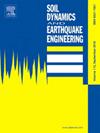Probabilistic assessment of soil liquefaction-induced failures during the 2023 Kahramanmaraş earthquakes in Türkiye: A case study from Iskenderun city
IF 4.2
2区 工程技术
Q1 ENGINEERING, GEOLOGICAL
引用次数: 0
Abstract
The February 6, 2023, Kahramanmaraş earthquakes and their aftershocks caused devastating destruction across Türkiye and Syria. Widespread liquefaction-induced damage—particularly in regions such as Iskenderun, Adıyaman-Gölbaşı, Hatay-Dörtyol, and Reyhanlı—was reported, along with general structural damage throughout the affected areas. This study addresses the critical issue of soil liquefaction within a probabilistic earthquake–soil–structure interaction framework and provides a comprehensive assessment of its impacts. An empirical methodology is proposed for estimating liquefaction-induced settlements near buildings by integrating post-earthquake reconnaissance observations with analytical results within a Performance-Based Design (PBD) framework. The analysis focuses on three regions within the Iskenderun district, which were selected based on observed evidence of liquefaction and underlying geotechnical characteristics. Geotechnical investigation reports and recorded ground motion data were employed to evaluate the influence of local soil conditions. Site effects were evaluated using one-dimensional site response analyses, which allowed for the simulation of ground motion amplification. The resulting surface acceleration time histories served as the basis for the damage assessment. To quantify liquefaction susceptibility, a data-driven classification of the Liquefaction Potential Index (LPI) was conducted using K-Means clustering, facilitating the derivation of optimized thresholds for damage severity. Based on this classification, empirical fragility functions were developed to relate the Liquefaction Potential Index (LPI) to the Damage Severity Index (DSI), enabling the estimation of exceedance probabilities for different damage states. The findings highlight the importance of probabilistic fragility modeling in enhancing seismic hazard mitigation strategies and informing risk-based engineering decisions.
2023年基耶省kahramanmaraki地震中土壤液化诱发破坏的概率评估:以Iskenderun市为例
2023年2月6日,kahramanmaraki地震及其余震在土耳其和叙利亚造成了毁灭性的破坏。据报道,液化引起的大面积破坏,特别是在伊斯肯德伦、Adıyaman-Gölbaşı、Hatay-Dörtyol和Reyhanlı-was等地区,以及整个受灾地区的普遍结构破坏。本研究在概率地震-土壤-结构相互作用框架下解决了土壤液化的关键问题,并提供了其影响的综合评估。在基于性能的设计(PBD)框架内,提出了一种将震后侦察观测结果与分析结果相结合的经验方法来估计建筑物附近液化引起的沉降。分析的重点是Iskenderun地区的三个地区,这些地区是根据观察到的液化证据和潜在的岩土特征选择的。利用岩土调查报告和记录的地面运动数据来评估当地土壤条件的影响。使用一维场地响应分析来评估场地效应,这允许模拟地面运动放大。所得的表面加速度时程作为损伤评估的依据。为了量化液化易感性,使用K-Means聚类对液化潜力指数(LPI)进行了数据驱动分类,便于导出损伤严重程度的优化阈值。在此基础上,建立了经验脆弱性函数,将液化潜力指数(LPI)与损伤严重程度指数(DSI)联系起来,从而可以估计不同损伤状态下的超出概率。研究结果强调了概率脆弱性建模在加强地震减灾战略和为基于风险的工程决策提供信息方面的重要性。
本文章由计算机程序翻译,如有差异,请以英文原文为准。
求助全文
约1分钟内获得全文
求助全文
来源期刊

Soil Dynamics and Earthquake Engineering
工程技术-地球科学综合
CiteScore
7.50
自引率
15.00%
发文量
446
审稿时长
8 months
期刊介绍:
The journal aims to encourage and enhance the role of mechanics and other disciplines as they relate to earthquake engineering by providing opportunities for the publication of the work of applied mathematicians, engineers and other applied scientists involved in solving problems closely related to the field of earthquake engineering and geotechnical earthquake engineering.
Emphasis is placed on new concepts and techniques, but case histories will also be published if they enhance the presentation and understanding of new technical concepts.
 求助内容:
求助内容: 应助结果提醒方式:
应助结果提醒方式:


